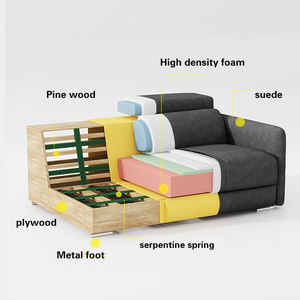Title: The Art and Science of Sofa Processing - Crafting Comfortable and Durable Furniture
Sofas are an essential part of our daily lives, providing us with comfort and relaxation after a long day. However, the production of a high-quality sofa requires both art and science. Crafting comfortable and durable furniture is not just about choosing the right materials and designing a visually appealing form - it also involves understanding the complex mechanisms of ergonomics and engineering. This article explores the art and science of sofa processing, from selecting the right foam density and upholstery fabric to ensuring proper support and stability. By combining these elements, furniture makers can create sofas that not only look great but also provide maximum comfort for their users. Whether you're in the market for a new sofa or simply want to learn more about how your current one was made, this article is sure to enlighten you on the fascinating process of crafting comfortable and durable furniture.
Introduction
Sofas are an essential component of modern living, providing comfort, relaxation, and style to any room. However, not all sofas are created equal. The quality of a sofa depends on its design, materials, manufacturing process, and most importantly, the skill of the craftsmen who bring it to life. This article will explore the art and science of sofa processing, detailing the various steps involved in crafting comfortable and durable furniture that lasts for years.

Design and Planning
The first step in sofa processing is design and planning. A skilled craftsman must have a deep understanding of ergonomics, comfort, and style to create a sofa that meets the needs of its users while also looking good. This involves studying human body geometry, determining the appropriate seat depth, armrest width, and backrest height, as well as choosing the right fabrics, colors, and patterns that complement each other.
Material Selection
The choice of materials is another critical factor in sofa processing. High-quality materials ensure that the sofa is both comfortable and durable. Common materials used in sofa manufacturing include leather, fabric, foam, and wood. Each material has its own unique properties, such as flexibility, resilience, durability, and appearance, which must be carefully considered when selecting the right one for a particular sofa design.
Fabric Selection and Fabrication
Once the design and materials have been chosen, the next step is fabric selection and fabrication. Fabric is the outer layer of a sofa that provides warmth, comfort, and style. It can be made from natural or synthetic materials such as cotton, wool, silk, or polyester. The fabric must be chosen based on factors such as durability, breathability, softness, and colorfastness.
After fabric has been selected, it is then cut into the desired shape and size using specialized machinery. The fabric may need to be sewn together to create complex patterns or shapes, such as pleats, tucks, or darts. Sewing techniques can vary depending on the type of fabric and the desired effect. For example, some stitches are stronger than others and may be better suited for certain fabrics or designs.
Frame Construction
The frame is the backbone of a sofa and plays a crucial role in ensuring its stability, comfort, and durability. There are several types of frames used in sofa manufacturing, including metal frames, wooden frames, and composite frames. Each type has its own advantages and disadvantages, such as strength, flexibility, weight, and cost.
The frame must be constructed to withstand the stresses imposed by the weight of the sofa and the use of its occupants. This involves attaching springs or foam padding to the frame to provide extra support and comfort. The frame may also need to be reinforced with metal or wooden supports to prevent warping or deformation over time.

Seat Construction
The seat is the main part of a sofa where people sit and relax. It must be designed to provide maximum comfort and support while also being aesthetically pleasing. The seat construction involves attaching cushions or pillows to the frame using screws or staples. The cushions may be made from foam or fabric padding covered with a soft fabric such as velvet or microfiber. The cushion thicknesses and densities can vary depending on factors such as user preferences and comfort level.
Armrest Construction
Armrests are optional components that provide additional comfort and support when sitting on a sofa. They can be made from various materials such as wood, metal, or plastic. The armrest construction involves cutting and shaping the material to fit around the arms of the couch and attaching it to the frame using screws or dowels. Armrests can also be padded with foam or fabric to enhance their comfort level.
Backrest Construction
The backrest is an essential component of a sofa that provides support for the spine and helps maintain proper posture. The backrest construction involves attaching springs or foam padding to the frame behind the seat cushions to create a supportive backrest. The backrest may also be covered with fabric or upholstered with foam padding to enhance its comfort level.
Finishing Touches
Once the basic construction of a sofa is complete, it is time for some finishing touches to make it look more stylish and appealing. These may include adding decorative elements such as buttons, zips
Articles related to the knowledge points of this article:
The Location of the羽绒服 Production Base
Title: Choosing the Perfect Tie for Your Wedding
Title: Embroidering Techniques: The Art of Knotting a Ribbon with the Chinese Knot (Ba Gua Zi)



